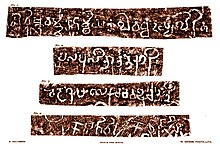| Kadamba script | |
|---|---|
 | |
| Script type | |
Time period | 4–7th century CE[1] |
| Direction | Left-to-right |
| Languages | Kannada Telugu Sanskrit Konkani |
| Related scripts | |
Parent systems | |
Child systems | Kannada-Telugu alphabet, Goykanadi,[2] Pyu script[3] |
| Brahmic scripts |
|---|
| The Brahmi script and its descendants |
The Kadamba script is the first writing system devised specifically for writing Kannada and it was later adopted to write Telugu language[4].The Kadamba script is also known as Pre-Old-Kannada script.
The Kadamba script is one of the oldest of the southern group of the Brahmi script. By the 5th century CE it became distinct from other Brahmi variants and was used in southern Indian states of Karnataka and Andhra Pradesh. It evolved into the Kannada-Telugu alphabet by the 10th century CE and was used to write Kannada and Telugu.[5] It is also related to the Sinhala script.[6]





